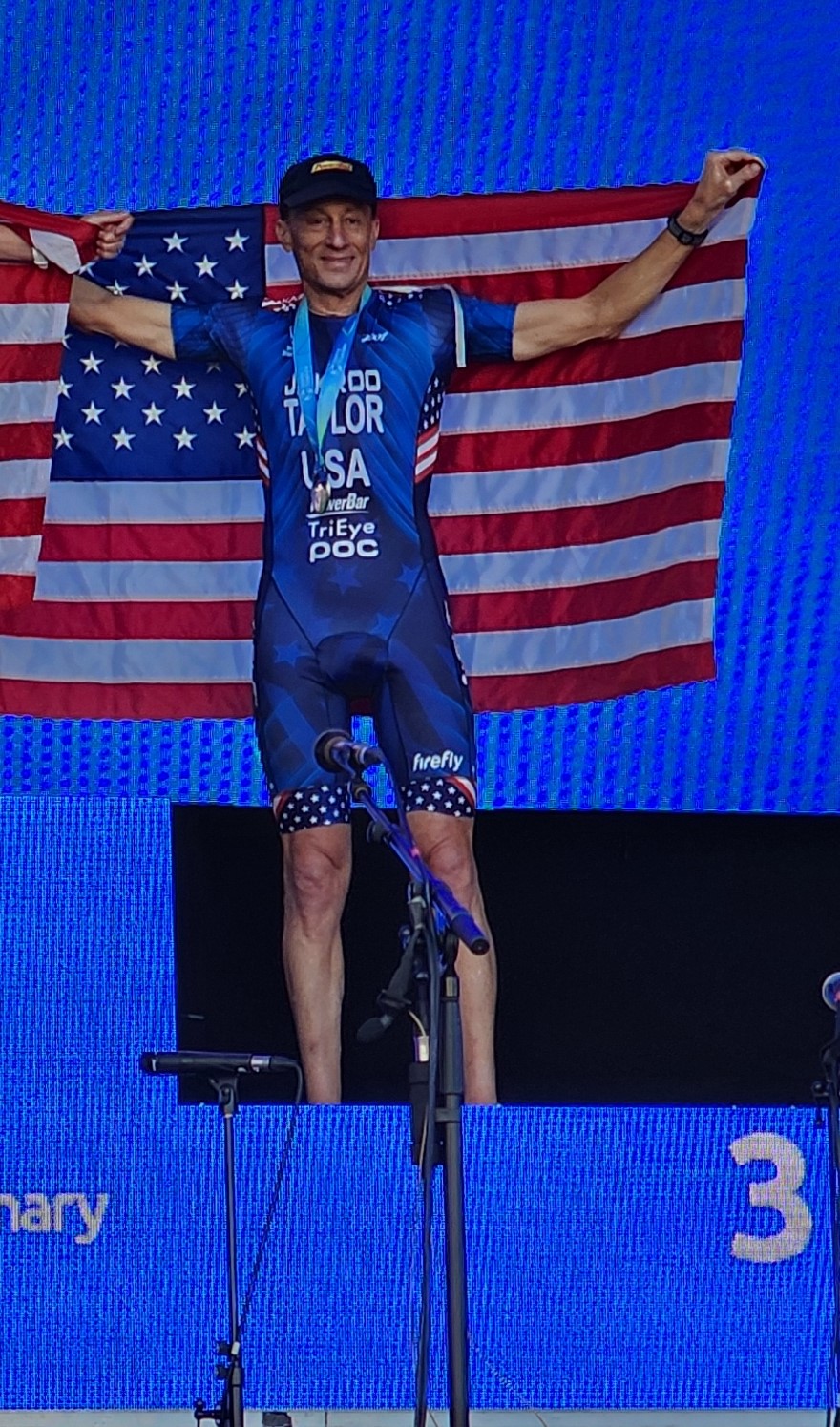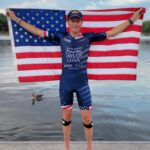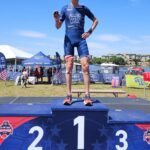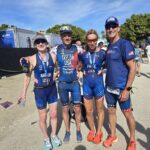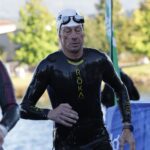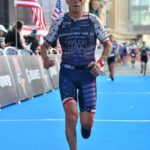Unfortunately, no, I didn’t strike gold at the World Super-sprint and Standard-distance Triathlon Championships, held in Pontevedra, Spain, last week, but I did collect another precious medal. But first, some back story.
These races were my fourth “A” series of triathlons in my 2023 season that began in April. Up to these Worlds, it had been a truly remarkable season that exceeded every  possible expectation I had after a very good 2022 season. My 2023 results to date include my first national age-group championship title, three other top-3 finishes at Nationals, and a 5th and 3rd at the World Sprint and Mixed-relay Championships, respectively, in Germany in July.
possible expectation I had after a very good 2022 season. My 2023 results to date include my first national age-group championship title, three other top-3 finishes at Nationals, and a 5th and 3rd at the World Sprint and Mixed-relay Championships, respectively, in Germany in July.
I approached the Pontevedra races in my best shape of the season, both physically and mentally. My coach, Dr. Greg Rhodes (Ph.D., Exercise Physiology) once again managed my training and racing masterfully. Interestingly, after an intense four-week training block after Nationals in early August, I hit rock bottom two weekends before Spain. That weekend, I had plans for an intense swim and long ride on Saturday followed by a high-intensity ride-run brick on Sunday. But when I woke on Saturday, I couldn’t get myself to do anything. The same thing happened on Sunday. I couldn’t even get motivated enough to do an easy spin all weekend. Obviously, I’m a very motivated guy, so, clearly, my body was sending a very loud message and, thankfully, my mind listened. Greg told me that the “hay was already in the barn,” so rest and recovery was far more important than a few intense workouts. Then, as Greg predicted, my mojo returned on Monday, I did a few more low-volume, high intensity workouts that week, and I left for Spain rested and fired up to race.
Saturday followed by a high-intensity ride-run brick on Sunday. But when I woke on Saturday, I couldn’t get myself to do anything. The same thing happened on Sunday. I couldn’t even get motivated enough to do an easy spin all weekend. Obviously, I’m a very motivated guy, so, clearly, my body was sending a very loud message and, thankfully, my mind listened. Greg told me that the “hay was already in the barn,” so rest and recovery was far more important than a few intense workouts. Then, as Greg predicted, my mojo returned on Monday, I did a few more low-volume, high intensity workouts that week, and I left for Spain rested and fired up to race.
 2023 was my first year as a true threat at the national and international levels and my successes so far in the season had steadily built my confidence leading up to Pontevedra. I was more confident and excited than ever before. I entered these races with the same two process goals that I have for every race: 1) execute my race plan flawlessly; and 2) leave it all out on the course.
2023 was my first year as a true threat at the national and international levels and my successes so far in the season had steadily built my confidence leading up to Pontevedra. I was more confident and excited than ever before. I entered these races with the same two process goals that I have for every race: 1) execute my race plan flawlessly; and 2) leave it all out on the course.
But my reality is that I’m a competitive guy in a competitive sport in a competitive world, and one reason I race is to see how I stack up against the best in the world. So, I can’t ignore that I have outcome goals for my “A” races. My race goals for Pontevedra included a podium in the Super-sprint, with a dream goal of winning a world tile, and a top-10 in the Standard-distance (I’ve accepted that I’m just faster at the shorter distances). I was also walking that fine line between expectations and goals that I struggled with in my previous “A” races. The added weight of these races was that, with success, you (and others) expect it to continue and even increase. Admittedly, I was not practicing what I preach with the athletes with whom I work. Plus, as I learned in previous World Championships, you never know who is going to show up, so there is little certainty about how realistic your race goals are.
winning a world tile, and a top-10 in the Standard-distance (I’ve accepted that I’m just faster at the shorter distances). I was also walking that fine line between expectations and goals that I struggled with in my previous “A” races. The added weight of these races was that, with success, you (and others) expect it to continue and even increase. Admittedly, I was not practicing what I preach with the athletes with whom I work. Plus, as I learned in previous World Championships, you never know who is going to show up, so there is little certainty about how realistic your race goals are.
One thing is for sure, I hadn’t been this positive and excited to race all season. At the same time, I  definitely felt some nerves as the Super-sprint approached. This was where I actually did practice what I preach by shifting to my process goals, that is, my race preparations and routines, combined with race imagery several times a day, leading up to race day.
definitely felt some nerves as the Super-sprint approached. This was where I actually did practice what I preach by shifting to my process goals, that is, my race preparations and routines, combined with race imagery several times a day, leading up to race day.
Super-sprint
The Super-sprint is an all-out, full-gas effort that involves a 300-meter swim, six-kilometer bike, and one-mile run and lasts under 30 minutes. It is truly a sprint from start to finish where every second counts (more on that last point shortly).
One of the great things about having a coach with a Ph.D. in Exercise Physiology is that he knows exactly what is required physiologically for an event like this. Also, thanks to lessons learned in previous Super- sprints this season, and drawing on my experience as a mental coach, I had a much better idea of what my ideal mindset needed to be to withstand the pain of such an intense effort. In my training leading up to this race and particularly on race morning, I focused on two things.
sprints this season, and drawing on my experience as a mental coach, I had a much better idea of what my ideal mindset needed to be to withstand the pain of such an intense effort. In my training leading up to this race and particularly on race morning, I focused on two things.
First, I steadily built my physical intensity and heart rate up before the start of the swim. I wasn’t still for a moment in the five minutes before my race began; I was doing squats, push-ups, and jumping up and  down. The rationale behind this is just like in drag racing. While waiting for the lights to go from red to yellow to green, the drivers don’t have their right foot off the gas pedal idling the engine because they know that going from 1000rpm to 10,000rpm in a few seconds will be show. Rather, they are revving their engines at 7,000 to 8,000rpm, so that when the light turns green and they slam the gas pedal down, they can quickly get up to 10,000rpm and blast off the line.
down. The rationale behind this is just like in drag racing. While waiting for the lights to go from red to yellow to green, the drivers don’t have their right foot off the gas pedal idling the engine because they know that going from 1000rpm to 10,000rpm in a few seconds will be show. Rather, they are revving their engines at 7,000 to 8,000rpm, so that when the light turns green and they slam the gas pedal down, they can quickly get up to 10,000rpm and blast off the line.
Second, I trained for and adopted an aggressive mindset before the race. Let me explain why. Our primitive brains don’t like and strongly resist any experience of pain. It’s an evolutionary thing; back on ![]() the Serengeti 250,000 years ago when we first officially became Home Sapiens, if we experienced pain, death was soon to follow. In fact, this resistance to pain began more than 250,000,000 years ago when living creatures first climbed out of the primordial muck. So, in redlining during a Super-sprint, we are trying to defy all those years of evolution.
the Serengeti 250,000 years ago when we first officially became Home Sapiens, if we experienced pain, death was soon to follow. In fact, this resistance to pain began more than 250,000,000 years ago when living creatures first climbed out of the primordial muck. So, in redlining during a Super-sprint, we are trying to defy all those years of evolution.
As the Super-sprint progresses, our primitive brain sends a message to our body with increased volume and vehemence to slow down or stop. If we don’t do anything to counter that message, that’s what will happen. Thankfully for triathletes in 2023, we also have an evolved brain (the cerebral cortex) that allows us to make choices and that’s where the aggressive mindset comes into play. As our primitive brain screams at us to stop, an aggressive mindset (e.g., “charge,” “attack!”) can override those primitive urges and allow our bodies to push hard in the face of growing discomfort.
us to make choices and that’s where the aggressive mindset comes into play. As our primitive brain screams at us to stop, an aggressive mindset (e.g., “charge,” “attack!”) can override those primitive urges and allow our bodies to push hard in the face of growing discomfort.
As part of my pre-race routine and continuing through each leg of the Super-sprint, my aggressive mindset was constantly exhorting my body to keep going hard. I had four “mantras” associated with my aggressive mindset:
- “Keep pushing!”
- “Dig deep!”
- “I choose to push my limits!”
- “Finish strong!”
Paradoxically, I also have trained myself to smile when I’m hurting. Though not directly related to an aggressive mindset, smiling has been found to dull pain by releasing endorphins, dopamine, and serotonin, our bodies natural relaxants and pain killers.
I did make three uncharacteristic mistakes in my pre-race preparations that, fortunately, didn’t impact my result, but may have slowed me down a bit during the run. One, I forgot to review my printed and laminated checklist to ensure I had all my transition-area ducks in a row. Two, because of that lapse, I forgot to put my caffeinated PowerBar chews in my bento box for the ride. Three, I also forgot to eat a packet of those PowerBar chews 30 minutes before my race. This hiccup was more troubling because it’s the second race in a row in which I did this. In the Sprint event at the USAT National Championships in Milwaukee in August, I made the same mistake. Unfortunately, that might have cost me 2nd place in the race because I ran toe-to-toe with Tim Brown (the silver medalist from the Standard distance the day before), but he got me by a few seconds at the finish. Would those PowerBar chews have given me that little bit of extra energy to take Tim at the finish? We’ll never know, but I have to admit that it gnaws at me when I think about it. Suffice it to say, I won’t make those mistakes again.
Now, to the race itself.
Swim. As I’m not a strong swimmer, my goal is always to minimize the damage out of the water. To give myself my best chance of a fast swim with little interference, I lined up as the second pair in the rolling start. My strategy worked brilliantly as I had clean water the entire swim. I pushed myself hard and I learned after the race that I was about 30 seconds behind the top guys out of the water. I was 12th faster (out of 30) on the swim in my age group; my most competitive swim ever.
T2. Another powerful lesson I’ve learned in the Super-sprint is that transitions can make or break races. There are two components to my transition in a Super-sprint. First, as soon as I got out of the water, I was sprinting as hard as I could both into and out of the transition area (TA). The particular configuration of the TA in Pontevedra was to my advantage as a runner because it involved .42 miles of running. I did lose some time having trouble getting my right bike shoe and helmet on (I find that putting my shoes on in transition rather than once I’ve mounted my bike is faster for me), but my T1 time was among the fastest in my age group.
Bike. I also haven’t historically been a particularly strong cyclist either, though I’ve improved a lot in 2023 due to a regimen of heavy lifting in the gym and a lot of HIIT workouts on my indoor trainer. My flying mount was a success and I clipped into my pedals and starting charging quickly after the mount line.
I find that focus is key to pushing my limits on the bike. If I get distracted, my primitive brain takes over and I slow down. So, I was constantly telling myself to keep pushing.
I’m always nervous about taking my feet out of my shoes and doing a flying dismount at the end of the bike, and my concern was accentuated in Pontevedra by the speed bumps before the dismount line. But I executed both flawlessly and began sprinting as soon as my bare feet hit the ground. I did have a problem in the run to the TA. One of my shoes, dangling off the pedals, caught on the pavement and my bike crashed to the ground. I picked it up quickly, but probably lost at least five seconds. I was 5th on the bike for my age group (which I was really pleased with).
I made several deliberate choices to speed up my T2. First, I wore my number belt under my wetsuit. Also, because it was such a short run, I didn’t wear a hat or sunglasses (putting them on usually costs me a second or two). I was able to get my shoes on quickly and sprinted out of T2 (another .32 miles of running before the actual run began).
Run. It all came down to the one-mile run. One complication with a rolling start is that you don’t actually know where you are. The best advice for this challenge came from Tim Yount, the TeamUSA leader, who said just to hammer start to finish. So that’s what I did, and I finished strong. I had the 2nd fastest run time (by one second) in my age group, so no complaints there.
Result. Now, to sate your curiosity about which precious medal I brought home in the Super-sprint, I earned the bronze again (my 3rd third in my last three World Championships). I had mostly achieved my process goals (i.e., execute my race plan pretty well and left it all out on the course) and I accomplished my outcome goal of a podium. I was 51 seconds out of 2nd place and 1:20 out of 1st, close enough to feel like I was in the game, but not so close that I was kicking myself for not having gone faster.
Another key triathlon lesson: every second counts (especially in the Super-sprint). The really exciting part of the race was that I beat the 4th place guy by less than a second (I thought him to be the prohibitive favorite for the race and the guy I wanted to beat)! Even more gratifying was that the fellow I bested beat me by six seconds for 2nd place in the 2022 Super-sprint World Championship in Abu Dhabi (because I blew my flying mount) and beat me by just over a minute to win the 2023 Sprint World Championship in Hamburg in July (where I finished 5th). I also beat him in the Standard-distance race two days later.
Standard-distance
I’ll keep this race summary brief because my Standard-distance result was solid, but not newsworthy. I finished 10th in my age group.
Having achieved my goal of a podium for the World Championships in the Super-sprint, I entered the race without expectations and completely relaxed. I executed my race plan well and left it out on the course. My swim was decent, my bike was okay, and I had the fourth fastest run in my age group. So, overall, a reasonably successful performance, though being the competitive guy that I am, I was a bit disappointed with my placing.
Overall, a very successful World Championships and I’m more motivated than ever for next season.

